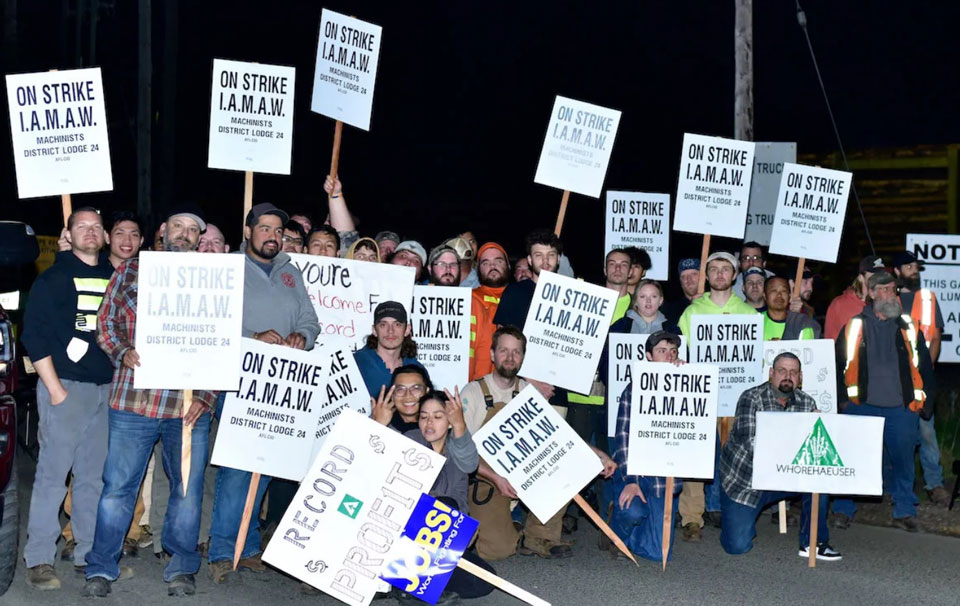
PORT ANGELES, Wash.—More than 1,100 sawmill workers, log truck drivers, and loggers are picketing Weyerhaeuser Corporation sawmills in Oregon and Washington, the first walkout to hit the giant lumber producer in 36 years.
The vote to strike was 98% after the strikers overwhelmingly rejected Weyerhaeuser’s take-it-or-leave it “best and final offer” Sept. 2.
Brandon Bryant, President and Business Agent of Woodworkers IAMAW District W24 in Longview, Wash., blasted Weyerhaeuser for reaping record profits while scheming to force their workers to accept a cheap wage settlement and sharp cutbacks in health care, job leave, and vacations.
“Our members, Weyerhaeuser’s workers, deserve better,” Bryant said in a press release. “All workers deserve better. Corporations have seen outlandish increases in their bottom line and those increases are only made with the hands and feet of workers. All wealth is the product of labor (John Locke). We are asking that our labor be recognized for its role in making wealth for Weyerhaeuser.”
He pointed out that the workers “worked through a once-in-a-lifetime pandemic as essential workers and came out of it to increase the company’s profits to new record territory.”
A story about the strike by Allana Madden in Courthouse News corroborates Bryant’s charge. Weyerhaeuser, she reported, admitted “record net earnings of $2.6 billion…on net sales of $10.2 billion—roughly a 226% increase from its net earnings of $797 million on net sales of $7.5 billion for the full year of 2020.”
Yet despite these skyrocketing profits, Weyerhaeuser refused to budge from its pitiful 5% proposed wage increase coupled with higher health care premiums and sharp cutbacks in vacations and paid leave.
Astronomical increases in the price of lumber is exerting a powerful inflationary pressure on housing construction and raises the danger of a collapse in the housing market and increases the risk of an economic recession. But it has fattened Weyerhaeuser profits and fueled their insatiable profit greed.
Since Weyerhaeuser limits contract negotiations to one day each week and has clung rigidly to its “best and final offer,” the workers suspect the company is stonewalling, scheming to starve the workers into submission.
That was the company’s strategy the last time Weyerhaeuser workers struck in 1986. That strike lasted six weeks before it was broken, the workers forced to return to their jobs with deep cuts in wages and benefits.
“Our over 1,100 members are holding the line,” Bryant said. “We have struck four lumber mills including two of the nation’s largest producing mills in Longview, Washington and Cottage Grove, Oregon.”
The strike, he added, will push down production of lumber on 2.6 million acres of forest in the Pacific Northwest. “We have struck the thousands and thousands of logging and highway roads our truck drivers drive. We struck because that work is essential to our community’s economy…and it is vitally essential for each and every IAM member who works at Weyerhaeuser to provide for their families and have a secure future.”
The International Woodworkers of America (IWA) was a left-led union targeted for vicious attacks by Cold War anti-communists in the 1950s who used the Taft Hartley Act in a witch hunt against then-IWA Vice President Karly Larsen.
This reporter, then 12 years old, went door to door in Port Angeles, Wash., with IWA loggers from the west end of Clallam County distributing leaflets urging defense of Larsen and an end to the war against the IWA.
That door-to-door leaflet campaign was organized and led by IWA logger Fred Gaboury, famed among all the loggers of Washington State as a fearless topper rigger. Gaboury became the editor of the rank-and-file magazine Labor Today and, after that, Labor Editor of People’s Weekly World, this publication. His pen name was “Hy Climber.”
Behind the drive to smash the IWA was the profit greedy Weyerhaeuser Timber Company. The IWA is now merged with the International Association of Machinists (IAM). The full story of that great union is told in the book One Union in Wood.
Now the loggers, truckers, and sawmill workers of the Pacific Northwest are upholding the IWA’s proud legacy.










